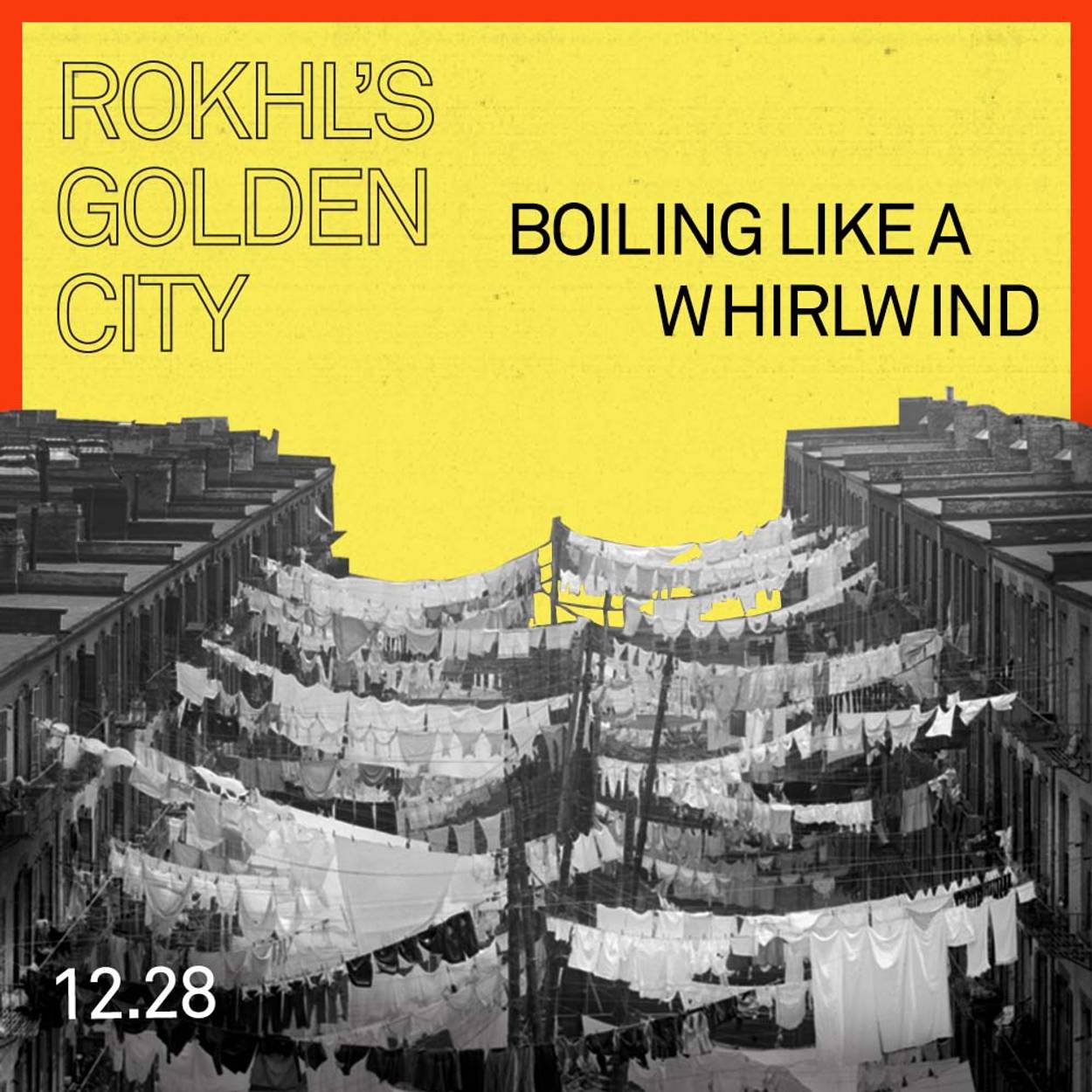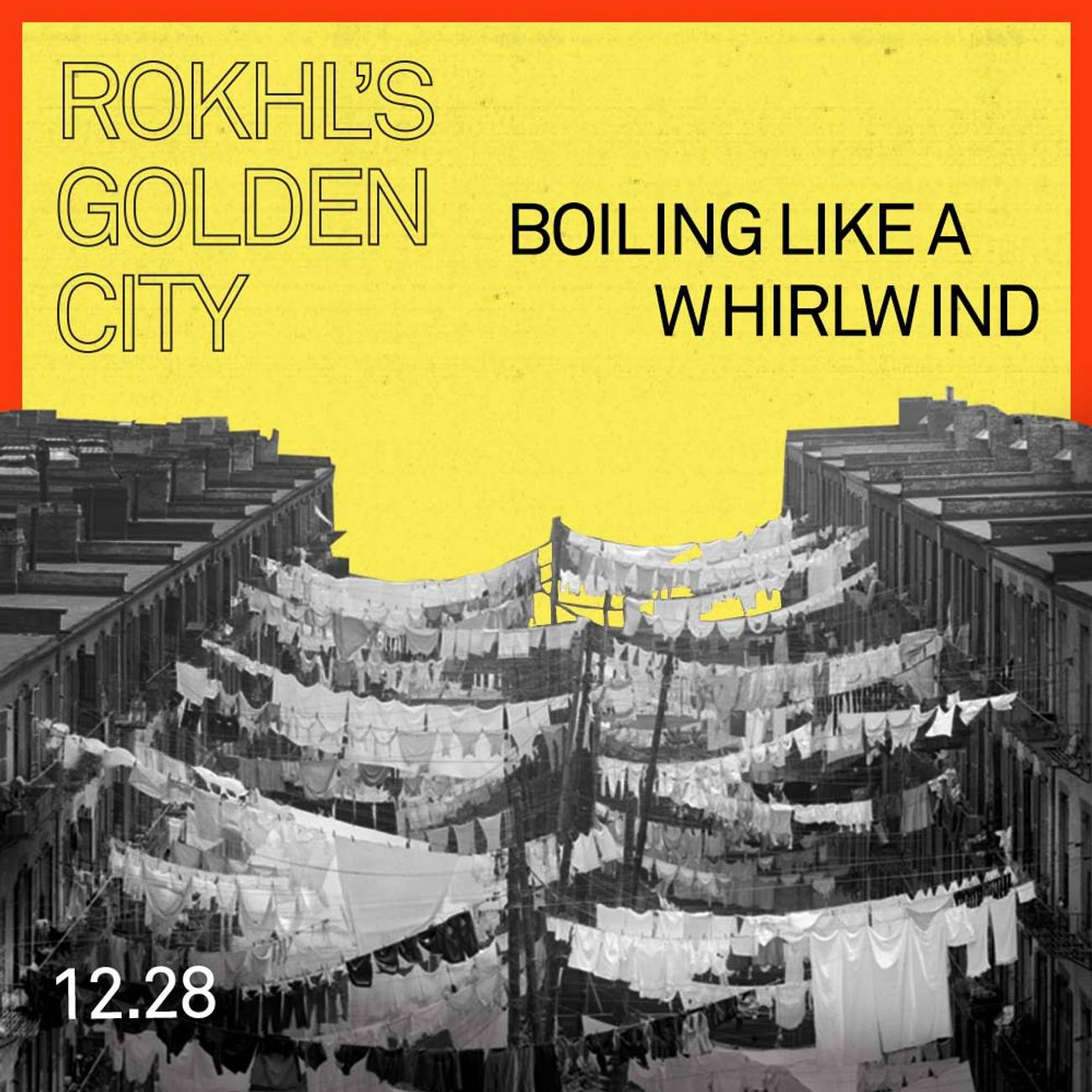Streets of New York
Rokhl’s Golden City: How the city is viewed in the Yiddish imagination




If you got your education about Yiddish immigrants in New York from the movies, it’s quite likely you’re walking around with this in your head:
The Mousekowitz family came to New York in 1885, at the very beginning of the massive migrations from Eastern Europe. They expressed the hope of many immigrants that old oppressions would be left behind and only golden opportunities lay ahead.
In 1917, Morris Rosenfeld published a poem called “Mayn amerike, undzer naye himne” (My America, Our New Hymn).
A bentshung dir, naye velt!
Dayn shvel af frayhayt iz geshtelt.
Amerike! Ikh hob dikh lib!
Un zogst du mir: “dayn lebn gib!
Ikh darf dayn mut, ikh darf dayn blut!”
Zolst du dos hobn di minut!
Ikh freg dikh nit: tsu vos? Tsu ven?—
Vos du farlangst, dos zol geshen.
A blessing for you, new world!
Your threshold stands on freedom.
America! I love you!
And say to me: “give your life!
I need your courage, I need your blood!”
You’ll have it this minute!
I won’t ask you why or wherefore—
Whatever you require, so it will be.
Rosenfeld wasn’t just dreaming of escape to a better life. His vision was painted in Jewish language, singing of an explicitly Jewish journey, one blessed by God. (Interestingly, you can hear an echo of Rosenfeld’s language in Irving Berlin’s 1918 song “God Bless America.”)
Rosenfeld was known as a “sweatshop” poet who, as the name suggests, produced a body of work far grimmer than his paean to America. Here we find a New York City as familiar to many of us in 2021 as it was in 1887. In “Mayn yingele” (My Little Boy) Rosenfeld writes:
Di arbet traybt mikh fri aroys,
Un lozt mikh shpet tsurik.
O, fremd iz mir mayn eygn layb,
O, fremd mayn kinds a blik.
Ikh kum tseklemterheyt aheym,
In fintsternish gehilt,
Mayn bleykhe froy dertseylt mir bald,
Vi fayn dos kind zikh shpilt.
My job drives me out early,
And lets me back in late.
O, foreign is my own body,
My own child’s looks.
I come distressed homeward,
Cloaked in darkness,
My pale wife soon tells me,
How nicely the child plays.
H. Altman’s “Di nyu yorker trern” (The New Yorker Tears) is even more explicit about the price extracted by his new home. Altman takes the pathos knob and cranks it up to 11:
In nyu-york kokht nor vi a keslgrub
Es rasht un es rudert gor un af her
Fil mentshn zet ir geyen um trib
Oft mol gefint ir bay mentshn a trer
Oy umglikn trefn do af yedn shrit
Un dokh vert dos gehenem nokh frayland genent
A familye shtelt men aroys do in shtrit
Vayl zey kenen nit pinktlekh batsoln dem rent
Es regnet es gist, di trern flist
Un zey zitsn nebekh farfinstert farvist
In New York it’s boiling like a whirlwind
It’s endlessly tumultuous and noisy
You see many people going about drearily
Often you’ll find people crying
Oy, you run into unhappiness here on every step
And hell is approaching the “freeland”
A family stands out here in the street
Because they can’t pay their rent on time
It’s raining, it’s pouring, the tears flow
And the poor things sit devastated, suffering
Altman’s song no doubt reflects the very real suffering of the immigrants of New York, with high rents, cruel landlords, and no money for doctors. (Oh wait, that’s my New York, too!) But if you look at the sheet music for the song, you’ll notice that the music is by Joseph Rumshinsky, one of the so-called “Big Four” composers of the Yiddish theater. Pathos and melodrama were what brought out audiences in droves to New York’s world-famous Yiddish theater scene.
New York was a nexus for labor organizing and revolutionary activity, as well-documented in the Yiddish literature and journalism of the day. But just as important was the role New York played in developing Yiddish theater. As Yiddish actor-writer Shane Baker describes in this delightful video, “Second Avenue” was known worldwide from 1911 until the 1950s.
Unfortunately, due to the speed at which New York’s landscape has changed, one must search closely for physical clues to those glory days. At first glance, it can be hard to separate the various layers of New York Yiddish archaeology, sorting the old-old from the just-looks-old. Doing my research for my previous column, on London Yiddish, I was surprised to learn that Brick Lane’s venerable Beigel Bake opened not in 1934, but 1974. And the Lower East Side’s premier den of chopped liver iniquity, Sammy’s Roumanian (which closed a year ago during the pandemic), only opened in 1975.
Obviously, ancient history is the stuff that happened the week before you were born. But even just a few years in the same place can make something feel “old.” The Yiddish New York festival only started in 2015, but it’s already gained a sense of permanence, becoming an important part of Jewish cultural life in New York. It’s a new-old Christmastime tradition, when beloved out of town friends call to ask how they can get an affordable apartment sublet in the East Village or where to get the best bagels. (Hurt feelings and fistfights may occur in both cases.)
What I love about Yiddish New York is its lively challenge to a certain nostalgic image, in which Yiddish in New York resides solely in sweatshops and tenement buildings. Indeed, not everything we love about Yiddish is to be found at the Tenement Museum. Except when it is …
On Jan. 20, the Tenement Museum will be hosting a live broadcast of a concert of Yiddish songs about New York. The songs and poems cited above all come from the program by composer Alex Weiser and are his translations. This new program is a follow up to his Pulitzer Prize-nominated 2019 album called and all the days were purple.
In a recent interview, Weiser (who, full disclosure, is a dear friend of mine) told me that what’s most exciting to him are the poems that reflect that “other” side of New York, not the stereotypical images of hustle bustle and noise, but the poems about the quiet and beauty of the city. He pointed to Morris Rosenfeld’s “Ovnt” (Evening) as the centerpiece of his Yiddish New York:
Af di palisadn rut di zun,
Varfndik ir letstn, zisn blik
Dem farlozenem hodson, velkher ligt
In zayn kalter zilber-bet fartrakht,
Murmlendik an umetik “gut nakht.”
Gute nakht dir, likht-printsesin, shtum
Vi a yugnt-kholem in di berg
Zinkstu, nemendik mit zikh di freyd!
Laykhtndik fargeystu in dayn prakht,
Lozndik di velt aleyn—gut nakht!
The sun rests on the Palisades
casting her last, sweet glance
to the forlorn Hudson, which lies
in its cold silver-bed lost in thought,
murmuring a lonely “good night.”
Good night to you, princess of light, silent
as a dream of youth on the shore
you’re sinking, taking joy with you!
Luminously setting in your splendor,
leaving the world alone—good night!
ALSO: Yoyzl bay di khasidim (Jesus in the Eyes of the Hasidim) explores the image of Jesus (and Christmas) in Hasidic thought. Dec. 27 (in Yiddish) … The entire Yiddish New York program is amazing, but if you like me, and you like what I do, you can sign up for my class on Dec. 29 about Jewish folklore in a disenchanted world … UCL’s Lily Kahn will speak on “Yiddish Metal as a Manifestation of Postvernacularity,” sponsored by the University of Chicago’s departments of Germanic studies and Jewish studies. Jan. 12, register here ... The good folks at Gefilteria will host the two-part Matzo Ball Soup sessions, just in time for all your wintertime ills in need of healing. Jan. 23 and Feb. 6. Register here … As of right now, London’s Jewish Music Institute (JMI) is going ahead in person with its Klezfest 2022. “Learn Klezmer, Play Klezmer,” April 3-7, 2022.
Rokhl Kafrissen is a New York-based cultural critic and playwright.